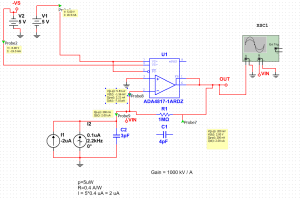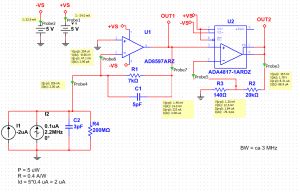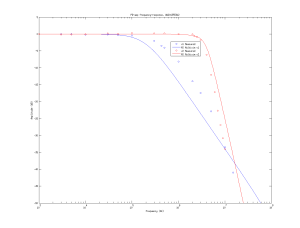The first design is a single transimpedance-amplifier (TIA) using an ADA4817 and a 1 MOhm resistor. This isn't a great design, since the op-amp is much too fast compared to what is needed/required here. The second design is a 7 kOhm TIA (AD8597) followed by a ~140 V/V gain non-inverting amp (ADA4817). This gives the same total effective gain of ~1 MOhm.
These circuits were designed for a 2 V output with a 2 uA photocurrent produced by about 5 uW of HeNe laser light at 633 nm. The output will hit the "roof" (the positive rail) at about 12 uW of optical power.
The agreement between simulation and experiment is not very good. I suspect my extremely simple LED-test is to blame. I should build a VCSEL circuit which allows testing these and other photodiode receivers to much higher frequencies.



Which colored line is which circuit?
Manufacture SPICE models are often off. I use gEDA and often have to add simulations to do model verifications kind of like a regression test in each simulation of my actual design simulations.
Relevant but not the answer. (Oh and I don't recommend TINA-TI)
http://e2e.ti.com/blogs_/b/thesignal/archive/2012/08/21/spice-it-up-but-does-bob-pease-say-no-august-22-2012.aspx
The blue line/data is the simple one op-amp transimpedance amplifier. Its bandwidth is limited by the RC lowpass frequency of the feedback resistor together with the photodiode capacitance and the op-amp input capacitance.
The red line/data is the circuit with a TIA followed by a non-inverting amplifier. This is probably the better design as the TIA can be made shot-noise-limited and with proper selection of resistors and gain the following stage will not degrade the SNR. I haven't (yet) properly made the noise calculations for this - on the to-do list...
The second amplifier is a good idea. Yes it raises noise but I usually add a second amplifier at unity gain just to drive the coax cable which is a mostly capacitive load.
What is the model number and vendor for the 1M Ohm feedback resistor? I tried to get a low noise composition with low inductance part for something very similar to this a while back and had some real trouble.
All resistors were 1206-sized SMD resistors from a WCR-series "general purpose surface mounted resistors" Welwyn kit.